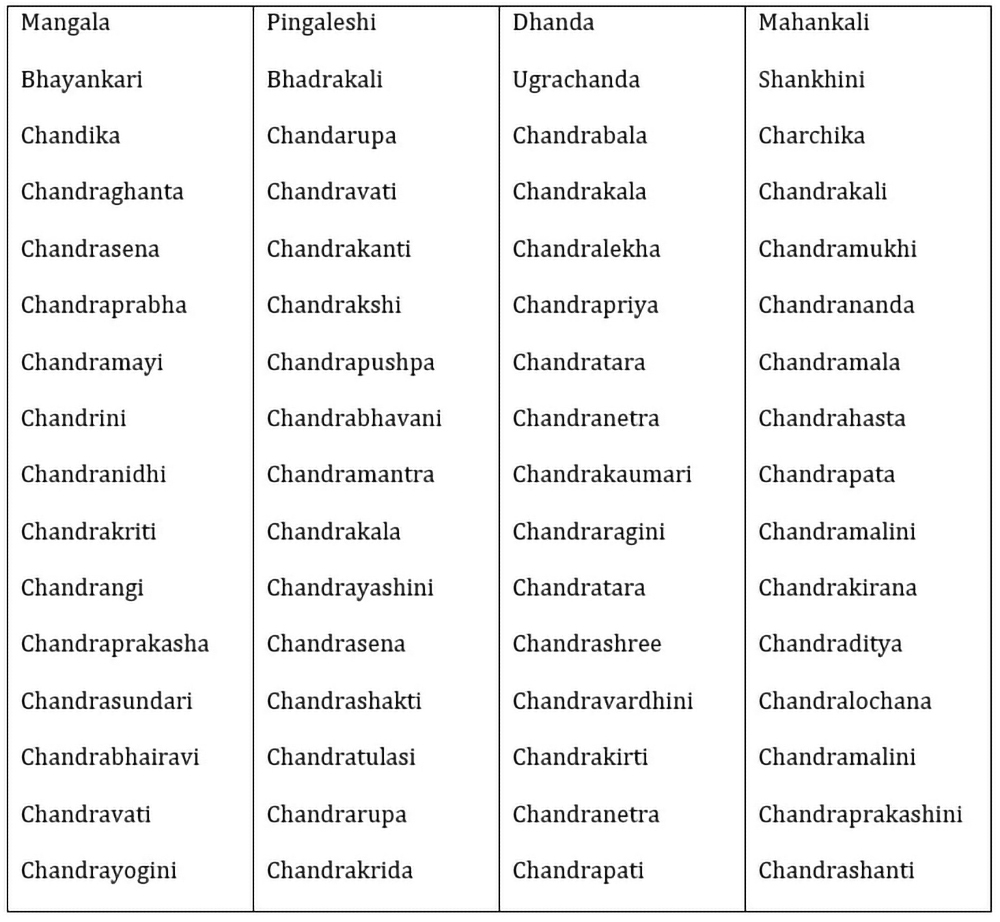The 64 Yoginis, often referred to as Chausath Yoginis in Sanskrit, are enigmatic divine entities worshipped within the esoteric traditions of Tantra in ancient and medieval India. These extraordinary beings symbolize the manifold aspects of Shakti, the primordial feminine energy that governs the cosmos. They embody power, wisdom, and mysticism, forming an integral part of India's spiritual heritage.
This article explores their origins, existence, powers, and purpose, delves into their temples, and sheds light on their unique place in mythology and spirituality.
Who are the 64 Yoginis?
The 64 Yoginis are revered as fierce and powerful manifestations of the divine feminine, each representing distinct energies and cosmic functions. They are considered both protectors and guides, capable of bestowing blessings or unleashing wrath, depending on the devotee’s discipline and intent.
These Yoginis are often depicted as semi-divine beings associated with Tantra. They are guardians of spiritual knowledge and possess supernatural abilities, including the power to control nature, defeat evil, and assist practitioners in attaining liberation (moksha).
In English, the Yoginis can be loosely compared to celestial beings like fairies, nymphs, or apsaras, but their role in Indian spirituality is far more profound. Unlike these Western or Vedic counterparts, the Yoginis are transformative deities, intricately tied to spiritual and cosmic balance.
Why do they exist?
The 64 Yoginis exist to channel the raw, untamed energy of the cosmos into focused, divine power. They symbolize the essence of feminine divinity in its myriad forms—both nurturing and destructive.
Their primary purposes include:
Empowerment of devotees: Yoginis guide seekers toward self-realization and spiritual mastery.
Protection against evil: as fierce warriors, they destroy demonic forces and safeguard sacred spaces.
Balancing energies: Yoginis maintain harmony between the material and spiritual realms.
Facilitating enlightenment: they assist in awakening Kundalini energy, leading to ultimate liberation.
Proof of their existence
Historical, scriptural, and archaeological evidence provides insight into the existence of the 64 Yoginis:
Scriptural mentions
Tantras and Agamas: texts such as the Kaula Tantra and Vamachara describe Yoginis as integral to Tantric rituals.
Kalika Purana: this Purana emphasizes their roles as fierce protectors and spiritual guides.
Devi Mahatmya: highlights their role as emanations of the Devi, fighting alongside her in battles.
Archaeological evidence
Temples dedicated to the Yoginis, dating from the 9th to 12th centuries CE, stand as physical proof of their veneration. These temples, typically circular and open to the sky, reflect their cosmic significance and their connection to the infinite.
What are their powers?
The 64 Yoginis possess extraordinary powers, which can be invoked through disciplined practices. Their abilities include:
-Granting Siddhis (Supernatural Powers): each Yogini governs a specific power, such as invisibility, flight, or mastery over elements.
-Healing and protection: they remove obstacles, cure ailments, and shield devotees from harm.
-Spiritual awakening: by awakening Kundalini energy, Yoginis help practitioners achieve higher states of consciousness.
The 64 Yoginis: few names, attributes, and mantras
Here is the list of the 64 Yoginis, their specific attributes, and their general invocation mantra:
Names and attributes
Mangala - Bringer of prosperity.
Pingaleshi - Destroyer of foes.
Dhanda - Embodiment of discipline.
Mahankali - Fierce protector.
Bhayankari - Granter of courage.
Bhadrakali - Benevolent and fierce.
Ugrachanda - Dispeller of darkness.
Shankhini - Protector of the sacred. (Complete list can be extended as per specific sources.)
General invocation mantra
Om Hrim Klim Chamundayai Vichche.
This mantra invokes the collective energy of the Yoginis and is used in Tantric rituals. Specific mantras for individual Yoginis can be provided under the guidance of a guru.
Where can we find Them?
The 64 Yoginis are predominantly worshipped in specific temples across India. These temples are unique in design, typically circular, symbolizing the cyclical nature of the universe.
Prominent Yogini temples
Hirapur Temple (Odisha): Built by the Bhauma-Kara dynasty, this temple is renowned for its exquisite carvings and spiritual ambiance.
Ranipur-Jharial (Odisha): A significant Tantric site with detailed depictions of the Yoginis.
Khajuraho Temple (Madhya Pradesh): Famous for its intricate sculptures and association with the Chandela dynasty.
Mitaoli Temple (Madhya Pradesh): An architectural marvel believed to have inspired the design of the Indian Parliament House.
The circular layout of these temples represents a yantra (mystical diagram), emphasizing the Yoginis’ role in channeling cosmic energies.
Who built these temples and why?
Most Yogini temples were constructed during the 9th-12th centuries by dynasties like the Chandelas and Bhauma-Karas. These rulers were patrons of Tantra and sought the Yoginis' blessings for military victories, prosperity, and spiritual protection.
The temples served as centers for advanced Tantric practices and meditation, offering a gateway to divine energies for devoted practitioners.
Are Yoginis fairies, apsaras, or nymphs?
While Yoginis share certain qualities with fairies, apsaras, and nymphs, they are far more powerful and complex. Unlike fairies (associated with nature) or apsaras (celestial dancers in Vedic traditions), Yoginis are fierce, divine entities embodying cosmic energies. They are both nurturing and terrifying, transcending the roles of mere celestial beings.
The most powerful Yogini
Among the 64, Chandika is often revered as the most powerful. She embodies both creation and destruction, symbolizing ultimate feminine power. Her ferocity in battle and her ability to grant liberation make her a pivotal figure in the Yogini pantheon.
Names of the 64 Yoginis
The exact names of the 64 Yoginis can vary depending on the temple and textual tradition. Below is a commonly referenced list based on inscriptions and traditions from various Yogini temples, such as Hirapur, Ranipur-Jharial, and Khajuraho.
The 64 Yoginis
This list reflects their names emphasizing lunar (Chandra) connections, symbolizing their cosmic and transformative energy.
Conclusion
The 64 Yoginis stand as timeless symbols of divine femininity, mysticism, and cosmic balance. Their legacy, preserved through temples, scriptures, and traditions, continues to inspire awe and reverence.
These enigmatic beings remind us of the boundless potential of spiritual energy, the transformative power of discipline, and the profound connection between the divine and the earthly. In studying and honoring the Yoginis, we delve into the heart of ancient Indian spirituality, where the sacred feminine reigns supreme.
















